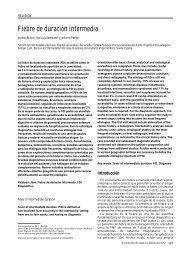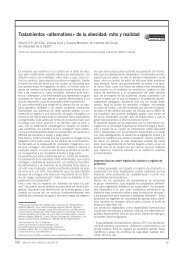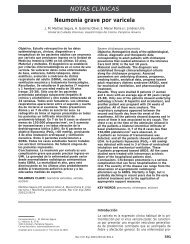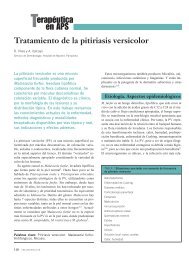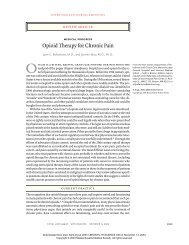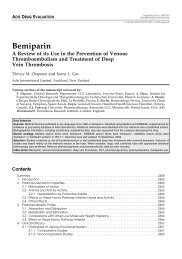Thiazolidinediones and type 2 diabetes: new drugs for ... - Cimerman
Thiazolidinediones and type 2 diabetes: new drugs for ... - Cimerman
Thiazolidinediones and type 2 diabetes: new drugs for ... - Cimerman
You also want an ePaper? Increase the reach of your titles
YUMPU automatically turns print PDFs into web optimized ePapers that Google loves.
NEW DRUGS OLD DRUGS<br />
NEW DRUGS, OLD DRUGS<br />
<strong>Thiazolidinediones</strong> <strong>and</strong> <strong>type</strong> 2 <strong>diabetes</strong>: <strong>new</strong> <strong>drugs</strong> <strong>for</strong> an old disease<br />
Trisha M O’Moore-Sullivan <strong>and</strong> Johannes B Prins<br />
ABSTRACT<br />
■ <strong>Thiazolidinediones</strong> are a <strong>new</strong> class of <strong>drugs</strong> <strong>for</strong> the<br />
treatment of <strong>type</strong> 2 <strong>diabetes</strong>, <strong>and</strong> act by improving insulin<br />
sensitivity The Medical in adipose Journal of tissue, Australia liver ISSN: <strong>and</strong> 0025-729X skeletal muscle. 15 April 2002<br />
176 8 381-386<br />
■ Rosiglitazone <strong>and</strong> pioglitazone are registered <strong>for</strong> use in<br />
©The Medical Journal of Australia 2002www.mja.com.au<br />
monotherapy, <strong>and</strong> in combination with sulfonylureas <strong>and</strong><br />
NEW DRUGS, OLD DRUGS<br />
met<strong>for</strong>min. Pioglitazone is also licensed <strong>for</strong> use in<br />
combination with insulin.<br />
■ There is level II evidence that in patients with inadequate<br />
glycaemic control<br />
• both <strong>drugs</strong> reduce the level of HbA 1c <strong>and</strong> fasting plasma<br />
glucose (FPG) when used as monotherapy <strong>and</strong> in<br />
combination with sulfonylurea or met<strong>for</strong>min or insulin;<br />
<strong>and</strong><br />
• both <strong>drugs</strong> increase levels of HDL <strong>and</strong> LDL <strong>and</strong> lower<br />
free fatty acid levels, but only pioglitazone significantly<br />
lowers triglyceride levels.<br />
■ Both <strong>drugs</strong> lower fasting insulin <strong>and</strong> C-peptide levels.<br />
■ In monotherapy, they may be slightly less potent at<br />
reducing the level of HbA 1c than sulfonylureas or<br />
met<strong>for</strong>min.<br />
■ The maximal effect of these agents may not be seen <strong>for</strong><br />
6–14 weeks after commencement.<br />
■ Both <strong>drugs</strong> are well tolerated but liver function must be<br />
checked at baseline every second month <strong>for</strong> the first year,<br />
<strong>and</strong> periodically thereafter.<br />
■ The <strong>drugs</strong> are currently contraindicated in patients with<br />
moderate to severe liver dysfunction <strong>and</strong> alanine<br />
aminotransferase levels more than 2.5 times normal, New<br />
York Heart Association III-IV cardiac status, pregnancy,<br />
lactation <strong>and</strong> in children.<br />
■ The main side effects include weight gain, oedema, <strong>and</strong><br />
mild dilutional anaemia.<br />
MJA 2002; 176: 381–386<br />
Department of Diabetes <strong>and</strong> Endocrinology, Princess<br />
Alex<strong>and</strong>ra Hospital, Woolloongabba, Brisbane, QLD.<br />
Trisha M O’Moore-Sullivan, MB BS, FRACP, Visiting Endocrinologist<br />
(<strong>and</strong> Senior Lecturer, Department of Medicine, University of Queensl<strong>and</strong>,<br />
<strong>and</strong> NMHRC Postgraduate Medical Research Fellow);<br />
Johannes B Prins, MB BS, PhD, FRACP, Director (<strong>and</strong> Associate<br />
Professor, Department of Medicine, University of Queensl<strong>and</strong>,<br />
<strong>and</strong> Wellcome Senior Research Fellow).<br />
Reprints will not be available from the authors. Correspondence: Dr Trisha<br />
M O’Moore-Sullivan, Department of Diabetes <strong>and</strong> Endocrinology, Princess<br />
Alex<strong>and</strong>ra Hospital, Ipswich Road, Woolloongabba, Brisbane, QLD 4102.<br />
tomoore@medicine.pa.uq.edu.au<br />
THE RECENT AUSDIAB DATA show that 7.2% of Australians<br />
over 25 years of age have <strong>type</strong> 2 <strong>diabetes</strong> mellitus <strong>and</strong> a<br />
further 16.1% have impaired glucose tolerance. In fact, 20%<br />
of Australians over 65 years have <strong>type</strong> 2 <strong>diabetes</strong> <strong>and</strong> it is<br />
well known that morbidity <strong>and</strong> mortality are significantly<br />
increased in affected patients. 1,2 However, there is evidence<br />
from the United Kingdom Prospective Diabetes Study<br />
(UKPDS) that good glycaemic control can improve morbidity<br />
by improving microvascular complications of <strong>type</strong> 2<br />
<strong>diabetes</strong>, such as retinopathy, nephropathy <strong>and</strong> neuropathy 3<br />
(E2). (See Box 1 <strong>for</strong> an explanation of level-of-evidence<br />
codes.) There is a well-recognised <strong>and</strong> strong association of<br />
<strong>type</strong> 2 <strong>diabetes</strong> with obesity <strong>and</strong> the insulin resistance<br />
syndrome. “Syndrome X” 5 refers to a collection of pathophysiological<br />
sequelae resulting from insulin resistance <strong>and</strong><br />
includes <strong>type</strong> 2 <strong>diabetes</strong>, as well as hypertension, dyslipidaemia,<br />
hyperuricaemia <strong>and</strong> elevated plasminogen-activatorinhibitor-1<br />
levels. 6<br />
Pathophysiologically, <strong>type</strong> 2 <strong>diabetes</strong> is characterised by<br />
defects in insulin action (ie, insulin resistance) <strong>and</strong> secretion<br />
(ie, -cell dysfunction), <strong>and</strong> increased hepatic glucose output.<br />
2 It is also well established that <strong>type</strong> 2 <strong>diabetes</strong> is a<br />
progressive condition, <strong>and</strong> that -cell failure ensues in many<br />
patients. The UKPDS showed that, although monotherapy<br />
with sulfonylureas, met<strong>for</strong>min or insulin can achieve good<br />
glycaemic control initially, sustained control with these<br />
agents fails in 50% of patients after three years. Most<br />
patients will require multiple therapies to obtain adequate<br />
long term glycaemic control (E2). 7<br />
Currently available therapies<br />
Currently available therapies <strong>for</strong> <strong>type</strong> 2 <strong>diabetes</strong> include<br />
various oral agents such as sulfonylureas, met<strong>for</strong>min, -<br />
glucosidase inhibitors (such as acarbose) <strong>and</strong> insulin. These<br />
agents can be used as monotherapy or in combination<br />
therapy. They have been used extensively, are efficacious<br />
<strong>and</strong> have a low incidence of serious adverse events. Recently,<br />
a <strong>new</strong> class of oral agents, the thiazolidinediones (TZDs),<br />
which act to improve the insulin sensitivity of peripheral<br />
tissues, has become available <strong>for</strong> use in clinical practice.<br />
Troglitazone was the first agent in this class <strong>and</strong> was<br />
effective, but was withdrawn because of severe <strong>and</strong> unpredictable<br />
hepatic failure. Newer TZDs such as rosiglitazone<br />
<strong>and</strong> pioglitazone are now available <strong>and</strong> have been approved<br />
by the Therapeutic Goods Administration (TGA) <strong>for</strong> use as<br />
monotherapy in patients with <strong>type</strong> 2 <strong>diabetes</strong> inadequately<br />
controlled by lifestyle measures, <strong>and</strong> also <strong>for</strong> use in combination<br />
with sulfonylureas or met<strong>for</strong>min in patients with<br />
inadequate glycaemic control. 8,9 Pioglitazone is also licensed<br />
<strong>for</strong> use in combination with insulin. 9 To date, hepatotoxicity<br />
does not appear to be a significant problem with these <strong>new</strong>er<br />
MJA Vol 176 15 April 2002 381
NEW DRUGS, OLD DRUGS<br />
1: Level-of-evidence codes<br />
Evidence <strong>for</strong> the statements made in this article is graded according<br />
to the NHMRC system 4 <strong>for</strong> assessing the level of evidence.<br />
E1<br />
E2<br />
E3 1<br />
E3 2<br />
E3 3<br />
E4<br />
Level I: Evidence obtained from a systematic review of all<br />
relevant r<strong>and</strong>omised controlled trials.<br />
Level II: Evidence obtained from at least one properly<br />
designed r<strong>and</strong>omised controlled trial.<br />
Level III-1: Evidence obtained from well-designed, pseudor<strong>and</strong>omised<br />
controlled trials (alternate allocation or some<br />
other method).<br />
Level III-2: Evidence obtained from comparative studies with<br />
concurrent controls <strong>and</strong> allocation not r<strong>and</strong>omised (cohort<br />
studies), case–control studies, or interrupted time series<br />
without a parallel control group.<br />
Level III-3: Evidence obtained from comparative studies with<br />
historical control, two or more single-arm studies, or interrupted<br />
time series without a parallel control group.<br />
Level IV: Evidence obtained from case-series, either posttest,<br />
or pre-test <strong>and</strong> post-test.<br />
agents. Neither drug is listed on the Pharmaceutical Benefits<br />
Scheme yet. A profile of these two <strong>drugs</strong> is shown in Box 2.<br />
<strong>Thiazolidinediones</strong> <strong>and</strong> peroxisome<br />
proliferator-activated receptor <br />
TZDs reduce hyperglycaemia by improving insulin sensitivity<br />
in a manner distinct from that of met<strong>for</strong>min. These <strong>drugs</strong><br />
increase peripheral glucose utilisation in skeletal muscle <strong>and</strong><br />
adipose tissue, reduce hepatic glucose output, increase fatty<br />
acid uptake <strong>and</strong> reduce lipolysis in adipose cells. This<br />
ultimately leads to a reduction in fasting <strong>and</strong> post-pr<strong>and</strong>ial<br />
plasma glucose, insulin <strong>and</strong> circulating free fatty acid (FFA)<br />
levels. 10 TZDs are believed to exert most of their effects<br />
through binding to <strong>and</strong> activation of the gamma iso<strong>for</strong>m of<br />
the peroxisome proliferator-activated receptor (PPAR).<br />
PPAR is a member of the steroid hormone nuclear receptor<br />
superfamily, <strong>and</strong> is found in adipose tissue, cardiac <strong>and</strong><br />
skeletal muscle, liver <strong>and</strong> placenta. On activation of this<br />
nuclear receptor by a lig<strong>and</strong> such as a TZD, PPAR–lig<strong>and</strong><br />
complex binds to a specific region of DNA <strong>and</strong> thereby<br />
regulates the transcription of many genes involved in glucose<br />
<strong>and</strong> fatty acid metabolism. 10 An endogenous lig<strong>and</strong> <strong>for</strong> this<br />
receptor has not been identified. Activation of PPAR also<br />
leads to stimulation of adipogenesis, 11 <strong>and</strong> this occurs more<br />
so in the subcutaneous rather than the omental fat depot. 12<br />
There are other iso<strong>for</strong>ms of PPAR, <strong>and</strong> one of these,<br />
PPAR-, is predominantly expressed in liver <strong>and</strong> is activated<br />
by hypolipidaemic agents such as fibrates. It mediates the<br />
triglyceride-lowering <strong>and</strong> high density lipoprotein (HDL)-<br />
raising effects of fibrates. Recent research has identified<br />
agents which are capable of activating PPAR <strong>and</strong> PPAR<br />
simultaneously, <strong>and</strong> which could potentially have even<br />
greater beneficial effects than current TZDs. The development<br />
of TZDs has also led to the identification of non-TZD<br />
compounds which are capable of acting as full or partial<br />
agonists or as antagonists of PPAR, depending on the<br />
tissue <strong>type</strong> <strong>and</strong> the specific target gene, in a manner<br />
analogous to the selective oestrogen receptor modulators<br />
2: Drug profile of rosiglitazone <strong>and</strong> pioglitazone<br />
Action: TZDs activate peroxisome proliferator-activated receptor <br />
(PPAR) <strong>and</strong> thereby regulate a number of genes involved in<br />
glucose <strong>and</strong> lipid metabolism. They act to improve insulin<br />
sensitivity.<br />
Onset: Both rosiglitazone <strong>and</strong> pioglitazone are rapidly absorbed<br />
<strong>and</strong> have high bioavailability. The timing of dose in relation to food<br />
does not significantly affect absorption or serum levels. Changes in<br />
fasting plasma glucose may start to be seen within two weeks, but<br />
maximal effects on glycaemic control may not be evident until 6–14<br />
weeks after commencement of therapy.<br />
Dosing: Both rosiglitazone <strong>and</strong> pioglitazone are available as oral<br />
<strong>for</strong>mulation. Rosiglitazone comes in 2 mg, 4 mg <strong>and</strong> 8 mg tablets<br />
<strong>and</strong> pioglitazone in 15 mg, 30 mg, <strong>and</strong> 45 mg tablets. No dosage<br />
adjustment is required <strong>for</strong> renal impairment.<br />
■ Recommended dose <strong>for</strong> rosiglitazone (Av<strong>and</strong>ia; GlaxoSmithKline)<br />
— Commence at 4 mg per day, <strong>and</strong>, if necessary, increase to<br />
8 mg per day after 6–8 weeks as a single or divided dose given<br />
with or without food. There is no additional benefit from doses<br />
higher than 8 mg per day. The largest dose given in combination<br />
with sulfonylurea in clinical studies was 2 mg twice daily.<br />
■ Recommended dose <strong>for</strong> pioglitazone (Actos; Eli Lilly) — Commence<br />
at 15 mg per day, <strong>and</strong>, if necessary, increase to 30 mg per<br />
day up to a maximum of 45 mg per day after 4–6 weeks. Give as<br />
a single dose with or without food. The largest daily dose used<br />
in clinical studies of pioglitazone in combination with insulin or<br />
sulfonylurea was 30 mg.<br />
Metabolism: Both <strong>drugs</strong> are extensively metabolised by hepatic<br />
cytochrome P450. Rosiglitazone metabolites are essentially inactive<br />
<strong>and</strong> mainly excreted in the urine. Some of the pioglitazone metabolites<br />
are active <strong>and</strong> are excreted in faeces <strong>and</strong> urine. Neither drug<br />
inhibits cytochrome P450. Although no significant drug interactions<br />
have so far been identified, prescribers should be vigilant <strong>for</strong><br />
possible interactions, especially with <strong>drugs</strong> metabolised by or<br />
affecting the cytochrome P450 system.<br />
Adverse effects: Both <strong>drugs</strong> are well tolerated. There have been<br />
some case reports of hepatic dysfunction in patients taking the two<br />
<strong>drugs</strong> but causation was not definite. The incidence of elevations in<br />
enzyme levels on liver function tests was the same in treatment <strong>and</strong><br />
placebo groups. The most common adverse effects include weight<br />
gain, oedema <strong>and</strong> dilutional anaemia. Because of fluid retention,<br />
these <strong>drugs</strong> may exacerbate heart failure <strong>and</strong> should not be<br />
prescribed to patients with New York Heart Association III-IV<br />
cardiac status. The <strong>drugs</strong> are also contraindicated in pregnancy<br />
<strong>and</strong> lactation <strong>and</strong> have not been tested in children. In women with<br />
polycystic ovarian syndrome with insulin resistance, treatment with<br />
these <strong>drugs</strong> may restore ovulation <strong>and</strong> appropriate advice regarding<br />
contraception should be given. When used in combination with<br />
other antidiabetic <strong>drugs</strong>, rosiglitazone <strong>and</strong> pioglitazone have been<br />
associated with mild hypoglycaemia requiring dose reduction of<br />
sulfonylurea, met<strong>for</strong>min or insulin.<br />
(SERMs). It is there<strong>for</strong>e possible that future agents will be<br />
more selective <strong>and</strong> specific in their effects <strong>and</strong> potentially<br />
safer <strong>and</strong> more efficacious. 13<br />
Clinical trials<br />
Although the evidence <strong>for</strong> therapy with these two agents is<br />
Level II, some of the data have either been published in<br />
abstract <strong>for</strong>m only, or are only available from pharmaceutical<br />
company sources or websites or other organisations like<br />
the United States Food <strong>and</strong> Drug Administration (FDA).<br />
There are few studies which directly compare these agents<br />
382 MJA Vol 176 15 April 2002
NEW DRUGS, OLD DRUGS<br />
as monotherapy or combination therapy with current st<strong>and</strong>ard<br />
treatment regimens. There are also no long term data on<br />
safety or effects on morbidity or mortality related to <strong>diabetes</strong><br />
<strong>and</strong> cardiovascular disease. There are no studies directly<br />
comparing rosiglitazone <strong>and</strong> pioglitazone. The clinical trial<br />
data are summarised below.<br />
◆<br />
Both <strong>drugs</strong> lower HbA 1c <strong>and</strong> fasting plasma glucose (FPG)<br />
levels when used as monotherapy 8,9,14-22 (E2)<br />
■ For rosiglitazone, there was a dose-dependent reduction<br />
in HbA 1c . The greatest effect was seen with a divided dose<br />
of 4 mg twice daily. In the various studies, this resulted in a<br />
reduction in HbA 1c level of between –0.6 <strong>and</strong> –0.8 percentage<br />
points compared with baseline, <strong>and</strong> –1.5 to –1.8<br />
compared with placebo. The FPG level was reduced by 2.3–<br />
3.6 mmol/L compared with baseline <strong>and</strong> 3.4–4.6 mmol/L<br />
compared with placebo.<br />
■ For pioglitazone, there was also a dose-dependent reduction<br />
in HbA 1c level of –0.9 percentage points compared with<br />
baseline, <strong>and</strong> –1.6 compared with placebo, <strong>for</strong> patients<br />
taking 45 mg per day. The FPG level was reduced by<br />
3.1 mmol/L compared with baseline, <strong>and</strong> 3.6 mmol/L compared<br />
with placebo.<br />
■ For both <strong>drugs</strong>, patients who were already receiving<br />
treatment with other agents at recruitment into the studies<br />
responded less well when swapped to monotherapy with the<br />
TZD than drug-naïve patients.<br />
◆<br />
Rosiglitazone <strong>and</strong> pioglitazone lower HbA 1c <strong>and</strong> FPG levels<br />
when used in combination with a sulfonylurea or<br />
met<strong>for</strong>min 8,9,23-26 (E2)<br />
■ Rosiglitazone (2 mg twice daily) added to various sulfonylureas<br />
over 26 weeks resulted in a reduction in HbA 1c<br />
level of –0.8 percentage points compared with baseline, <strong>and</strong><br />
–1.0 compared with placebo plus sulfonylurea. The FPG<br />
level was reduced by 2.09 mmol/L.<br />
■ When added to met<strong>for</strong>min (2.5 g), rosiglitazone (8 mg<br />
per day) reduced the HbA 1c level by –0.78 percentage<br />
points <strong>and</strong> the FPG level by 2.7 mmol/L compared with<br />
baseline, <strong>and</strong> reduced the HbA 1c level by –1.2 percentage<br />
points <strong>and</strong> the FPG level by 2.9 mmol/L compared with<br />
placebo plus met<strong>for</strong>min.<br />
Pioglitazone (30 mg) added to sulfonylurea reduced the<br />
HbA 1c level by –1.3 percentage points compared with<br />
baseline <strong>and</strong> the FPG level was reduced by 2.9 mmol/L.<br />
■ When pioglitazone was added to met<strong>for</strong>min, the HbA 1c<br />
level was reduced by about –0.7 percentage points, <strong>and</strong> the<br />
FPG level fell by 2.4 mmol/L compared with baseline.<br />
Compared to placebo plus met<strong>for</strong>min, pioglitazone (30 mg)<br />
plus met<strong>for</strong>min reduced the HbA 1c level by –0.83 percentage<br />
points <strong>and</strong> the FPG level by 2.1 mmol/L.<br />
(respectively) compared with baseline <strong>and</strong> –0.7 <strong>and</strong> –1.3<br />
compared with placebo plus insulin. Congestive heart failure<br />
was reported in two patients in each rosiglitazone group<br />
(comprising 106 <strong>and</strong> 103 patients) <strong>and</strong> one in the placebo<br />
group (103 patients). Rosiglitazone is not registered <strong>for</strong> use<br />
in combination with insulin. 27<br />
■ Pioglitazone (15 mg or 30 mg) per day added to insulin<br />
reduced HbA 1c levels by –0.99 <strong>and</strong> –1.26 percentage points<br />
(respectively) compared with baseline <strong>and</strong> –0.73 <strong>and</strong> –1.00<br />
compared with placebo plus insulin. Sixteen per cent of<br />
patients in the 30 mg pioglitazone plus insulin group had a<br />
reduction in their insulin dose of more than 25%. 28<br />
■ In these two studies, the incidence of oedema was<br />
significantly increased in the groups treated with TZD plus<br />
insulin. 27,28<br />
◆<br />
Both <strong>drugs</strong> lower fasting insulin <strong>and</strong> C-peptide levels when<br />
used as monotherapy or in combination therapy 8,9,14-26 (E2)<br />
■ The significant reduction in insulin <strong>and</strong> C-peptide levels<br />
is consistent with the mechanism of action of these <strong>drugs</strong> as<br />
insulin sensitisers.<br />
◆<br />
Both <strong>drugs</strong> increase HDL <strong>and</strong> LDL <strong>and</strong> decrease FFA levels;<br />
pioglitazone lowers triglyceride levels 8,9,14-32 (E2)<br />
■ Rosiglitazone significantly increased low-density lipoprotein<br />
(LDL) levels (mean increase, 15%–20% 29 ) compared<br />
with baseline <strong>and</strong> controls, whereas, although pioglitazone<br />
increased LDL levels compared with baseline, there was no<br />
difference compared with controls.<br />
■ Rosiglitazone also tends to increase total cholesterol level<br />
<strong>and</strong> studies have reported variable effects on ratios of<br />
triglyceride to high-density lipoprotein (HDL) <strong>and</strong> of LDL<br />
to HDL. In patients taking rosiglitazone, the ratios are either<br />
unchanged or increased. In studies over six months, the<br />
ratios tended to be unchanged because LDL reached a<br />
plateau <strong>and</strong> HDL continued to increase. There is a trend <strong>for</strong><br />
these ratios to decrease in patients treated with pioglitazone.<br />
■ A recent, small, non-r<strong>and</strong>omised <strong>and</strong> unblinded study<br />
suggested that pioglitazone increased levels of HDL to a<br />
greater, <strong>and</strong> LDL to a lesser, extent than rosiglitazone 30<br />
(E4). No r<strong>and</strong>omised comparative study has been undertaken.<br />
■ It is known that modest increases in LDL levels correlate<br />
with increased cardiovascular risk. However, as has been<br />
reported <strong>for</strong> troglitazone, 6 the increase in LDL level associated<br />
with rosiglitazone <strong>and</strong> pioglitazone is mainly in the<br />
larger, more buoyant <strong>and</strong> less atherogenic particles of<br />
LDL. 31,32<br />
■<br />
■<br />
Pioglitazone significantly reduced triglyceride levels.<br />
The long term effects of these alterations in lipid profile<br />
are unknown.<br />
◆<br />
Rosiglitazone <strong>and</strong> pioglitazone lower HbA 1c <strong>and</strong> FPG levels<br />
when used in combination with insulin 8,9,27,28 (E2)<br />
■ Rosiglitazone (4 mg or 8 mg per day) added to insulin<br />
reduced HbA 1c levels by –0.6 <strong>and</strong> –1.2 percentage points<br />
Comparison with current antidiabetic <strong>drugs</strong><br />
In a published abstract <strong>and</strong> in the product in<strong>for</strong>mation,<br />
rosiglitazone (2 mg twice daily <strong>and</strong> 4 mg twice daily) was<br />
directly compared with glibenclamide (or glyburide) at<br />
MJA Vol 176 15 April 2002 383
NEW DRUGS, OLD DRUGS<br />
3: Important messages <strong>for</strong> patients<br />
<strong>Thiazolidinediones</strong> (TZDs):<br />
■ Are a <strong>new</strong> <strong>type</strong> of drug <strong>for</strong> the treatment of <strong>type</strong> 2 <strong>diabetes</strong>.<br />
■ Improve diabetic control by increasing the body’s sensitivity<br />
to insulin.<br />
■ Can cause mildly low blood sugar levels if they are used in<br />
combination with other medications <strong>for</strong> <strong>diabetes</strong>.<br />
■ Can cause some weight gain <strong>and</strong> mild fluid retention.<br />
■ Should not be taken if you are pregnant or breastfeeding or if you<br />
have significant heart or liver problems.<br />
Your doctor may need to advise you about methods of<br />
contraception, as you should not become pregnant while taking<br />
these medications.<br />
You will need to have regular liver function tests.<br />
“optimally titrated dose”. Patients in all three groups<br />
showed a statistically significant improvement in glycaemic<br />
control. The HbA 1c level fell 0.27% <strong>and</strong> 0.53%, respectively,<br />
<strong>for</strong> the two rosiglitazone groups <strong>and</strong> 0.72% <strong>for</strong> the<br />
glibenclamide group at one year. 8,33 Rosiglitazone was said<br />
to be “statistically equivalent” to glibenclamide at lowering<br />
HbA 1c at one year, although the mean dose of glibenclamide<br />
is not stated (but, according to the FDA website, is 7.5 mg/<br />
day), 29 <strong>and</strong> the graph in the product in<strong>for</strong>mation shows that<br />
there was a deterioration in glycaemic control in the first six<br />
months in the two rosiglitazone groups. There was no<br />
statistical analysis provided <strong>for</strong> any time points other than<br />
one year. Rosiglitazone at 4 mg twice daily resulted in a<br />
significantly greater reduction in FPG level at one year than<br />
glibenclamide (–2.3 mmol/L v –2.0 mmol/L, respectively;<br />
P
NEW DRUGS, OLD DRUGS<br />
status were excluded from the studies (both <strong>drugs</strong> are<br />
contraindicated in these patients). This increase in plasma<br />
volume is also likely to be responsible <strong>for</strong> the mild reduction<br />
in haemoglobin level seen with all TZDs. 6<br />
Precautions<br />
There are no data on the use of these <strong>drugs</strong> in pregnancy or<br />
lactation. In animal studies both <strong>drugs</strong> cross the placenta,<br />
<strong>and</strong> fetal loss, retarded fetal development <strong>and</strong> suppression of<br />
postnatal growth have been seen in rats. 8,9 There were no<br />
significant effects on levels of the oral contraceptive pill in<br />
healthy women taking rosiglitazone, <strong>and</strong> the drug’s manufacturer<br />
reports that no impairment of efficacy would be<br />
expected. 8,42 There is no similar study <strong>for</strong> pioglitazone, but<br />
the product in<strong>for</strong>mation recommends that alternative<br />
modes of contraception be used. 9 Women with polycystic<br />
ovarian syndrome <strong>and</strong> insulin resistance should be advised<br />
that treatment with TZDs may result in resumption of<br />
ovulation <strong>and</strong> advice regarding suitable contraception<br />
should be given. 8,9<br />
Both <strong>drugs</strong> are contraindicated in moderate to severe liver<br />
dysfunction. Dose reduction is not required in elderly<br />
patients or those with renal impairment. 8,9 Although animal<br />
studies have shown tumour-inducing effects <strong>for</strong> familial<br />
adenomatous polyposis <strong>and</strong> sporadic colon cancer in mice,<br />
there are no clinical data yet. 43 However, mutagenicity <strong>and</strong><br />
carcinogenicity studies have not raised any other significant<br />
concerns. 8,9 These agents should be avoided in patients with<br />
significant cardiac dysfunction. There are no data in<br />
humans under 18 years of age.<br />
Conclusions <strong>and</strong> recommendations<br />
The thiazolidinediones are a unique class of <strong>drugs</strong> <strong>for</strong> the<br />
management of <strong>type</strong> 2 <strong>diabetes</strong> <strong>and</strong> they act to improve<br />
insulin resistance. Current evidence suggests that they are<br />
effective in the treatment of <strong>type</strong> 2 <strong>diabetes</strong>, but there is no<br />
evidence to suggest that they are better than currently<br />
available <strong>drugs</strong> <strong>and</strong> no data on long term safety or effects on<br />
morbidity <strong>and</strong> mortality related to <strong>diabetes</strong> <strong>and</strong> cardiovascular<br />
disease. Since the mechanism of action of TZDs is<br />
different from other currently available antidiabetic agents,<br />
it seems logical that they would be useful in combination<br />
therapy. So far, there are no studies assessing the effect of<br />
the TZDs when added to the combination of sulfonylurea<br />
<strong>and</strong> met<strong>for</strong>min, or to insulin combined with sulfonylurea or<br />
met<strong>for</strong>min. There is little difference between the two agents,<br />
although pioglitazone may have a more favourable effect on<br />
lipid profile than rosiglitazone. There are some data that<br />
show that these <strong>drugs</strong> may preserve beta-cell function, <strong>and</strong> it<br />
has been suggested that they should there<strong>for</strong>e be used early<br />
in the disease process, but there are no studies to support<br />
this hypothesis. Until there are more data available, these<br />
agents should probably be reserved <strong>for</strong> use in combination<br />
therapy in patients who are unable to be managed with<br />
current st<strong>and</strong>ard treatment combinations (ie, met<strong>for</strong>min,<br />
sulfonylurea, acarbose <strong>and</strong> insulin), 44,45 <strong>and</strong> who fulfil the<br />
current prescribing guidelines. The development of thiazolidinediones<br />
has opened the door to some exciting research<br />
<strong>and</strong> to the development of other <strong>new</strong> agents <strong>for</strong> the treatment<br />
of <strong>type</strong> 2 <strong>diabetes</strong> mellitus. Important messages <strong>for</strong><br />
patients are shown in Box 3.<br />
Competing interests<br />
The authors have received competitive funding <strong>for</strong> basic scientific research from Novo<br />
Nordisk <strong>and</strong> from Eli Lilly. The views expressed in this article are those of the authors<br />
<strong>and</strong> neither company has had input into the content.<br />
References<br />
1. AusDiab preliminary results media release. 30 May 2000. <br />
2. DeFronzo RA. Pharmacologic therapy <strong>for</strong> <strong>type</strong> 2 <strong>diabetes</strong> mellitus. Ann Intern<br />
Med 1999; 131: 281-303.<br />
3. UK Prospective Diabetes Study (UKPDS) Group. Intensive blood-glucose control<br />
with sulphonylureas or insulin compared with conventional treatment <strong>and</strong> risk of<br />
complications in patients with <strong>type</strong> 2 <strong>diabetes</strong> (UKPDS 33). Lancet 1998; 352:<br />
837-853.<br />
4. National Health <strong>and</strong> Medical Research Council. A guide to the development,<br />
implementation <strong>and</strong> evaluation of clinical practice guidelines. Canberra:<br />
NHMRC, AusInfo, 1999.<br />
5. Reaven GM. Role of insulin resistance in human disease. Diabetes 1988; 37:<br />
1595-1607.<br />
6. Parulkar AA, Pendergrass ML, Gr<strong>and</strong>a-Ayala R, et al. Nonhypoglycaemic effects<br />
of thiazolidinediones. Ann Intern Med 2001; 134: 61-71.<br />
7. Turner RC, Cull CA, Frighi V, Holman RR. Glycemic control with diet, sulfonylurea,<br />
met<strong>for</strong>min, or insulin in patients with <strong>type</strong> 2 <strong>diabetes</strong> mellitus. Progressive<br />
requirement <strong>for</strong> multiple therapies (UKPDS 49). JAMA 1999; 281: 2005-2012.<br />
8. Av<strong>and</strong>ia (rosiglitazone maleate) product in<strong>for</strong>mation. D<strong>and</strong>enong, Victoria:<br />
SmithKline Beecham (Aust) Pty Ltd, 6 July 2000.<br />
9. Actos (pioglitazone hydrochloride) product in<strong>for</strong>mation. West Ryde, NSW: Eli Lilly<br />
Pty Ltd Australia, 3 Jan 2001.<br />
10. Olefsky JM. Treatment of insulin resistance with peroxisome proliferator-activated<br />
receptor agonists. J Clin Invest 2000; 106: 467-472.<br />
11. Spiegelman BM. PPAR: Adipogenic regulator <strong>and</strong> thiazolidinedione receptor.<br />
Diabetes 1998; 47: 507-514.<br />
12. Adams M, Montague CT, Prins JB, et al. Activators of peroxisome proliferatoractivated<br />
receptor have depot specific effects on human preadipocyte<br />
differentiation. J Clin Invest 1997; 100: 3149-3153.<br />
13. Zhang BB, Moller DE. New approaches in the treatment of <strong>type</strong> 2 <strong>diabetes</strong>. Curr<br />
Opin Chem Biol 2000; 4: 461-467.<br />
14. Phillips LS, Grunberger G, Miller E, et al. Once- <strong>and</strong> twice-daily dosing with<br />
rosiglitazone improves glycemic control in patients with <strong>type</strong> 2 <strong>diabetes</strong>.<br />
Diabetes Care 2001; 24: 308-315.<br />
15. Lebovitz HE, Dole JF, Patwardhan R, et al. Rosiglitazone monotherapy is effective<br />
in patients with <strong>type</strong> 2 <strong>diabetes</strong>. J Clin Endocrinol Metab 2001; 86: 280-288.<br />
16. Raskin P, Rappaport EB, Cole ST, et al. Rosiglitazone short-term monotherapy<br />
lowers fasting <strong>and</strong> post-pr<strong>and</strong>ial glucose in patients with <strong>type</strong> II <strong>diabetes</strong>.<br />
Diabetologia 2000; 43: 278-284.<br />
17. Nolan JJ, Jones NP, Patwardhan R, Deacon LF. Rosiglitazone taken once daily<br />
provides effective glycaemic control in patients with <strong>type</strong> 2 <strong>diabetes</strong> mellitus.<br />
Diabet Med 2000; 17: 287-294.<br />
18. Goldstein B, Salzman A. Rosiglitazone is effective in poorly controlled <strong>type</strong> 2<br />
<strong>diabetes</strong> patients [abstract]. Diabetologia 1999; 42 Suppl 1: A229.<br />
19. Rebuck AS, Weill S, Patwardhan R. Rosiglitazone given once or twice daily is<br />
effective first-line treatment <strong>for</strong> <strong>type</strong> 2 <strong>diabetes</strong> mellitus [abstract]. Diabetologia<br />
1999; 42 Suppl 1: A231.<br />
20. Aronoff S, Rosenblatt S, Braithwaite S, et al. Pioglitazone hydrochloride monotherapy<br />
improves glycemic control in the treatment of patients with <strong>type</strong> 2<br />
<strong>diabetes</strong>. Diabetes Care 2000; 23: 1605-1611.<br />
21. Mathisen A, Geerlof J, Houser V. The effect of pioglitazone on glucose control<br />
<strong>and</strong> lipid profile in patients with <strong>type</strong> 2 <strong>diabetes</strong> [abstract]. Diabetes 1999; 48<br />
Suppl 1: A102-A103.<br />
22. Gillies PS, Dunn CJ. Pioglitazone. Drugs 2000; 60: 333-343.<br />
23. Wolffenbuttel BHR, Gomis R, Squatrito S, et al. Addition of low-dose rosiglitazone<br />
to sulphonylurea therapy improves glycaemic control in <strong>type</strong> 2 diabetic patients.<br />
Diabet Med 2000; 17: 40-47.<br />
24. Fonseca V, Rosenstock J, Patwardhan R, Salzman A. Effect of met<strong>for</strong>min <strong>and</strong><br />
rosiglitazone combination therapy in patients with <strong>type</strong> 2 <strong>diabetes</strong> mellitus. A<br />
r<strong>and</strong>omized controlled trial. JAMA 2000; 283: 1695-1702.<br />
MJA Vol 176 15 April 2002 385
NEW DRUGS, OLD DRUGS<br />
25. Kipnes MS, Krosnick A, Rendell MS, et al. Pioglitazone hydrochloride in<br />
combination with sulfonylurea therapy improves glycemic control in patients with<br />
<strong>type</strong> 2 <strong>diabetes</strong> mellitus: A r<strong>and</strong>omized, placebo-controlled study. Am J Med<br />
2001; 111: 10-17.<br />
26. Einhorn D, Rendell M, Rosenzweig J, et al. Pioglitazone hydrochloride in<br />
combination with met<strong>for</strong>min in the treatment of <strong>type</strong> 2 <strong>diabetes</strong> mellitus: a<br />
r<strong>and</strong>omized, placebo-controlled study. Clin Ther 2000; 22: 1395-1409.<br />
27. Raskin P, Rendell M, Riddle M, et al. A r<strong>and</strong>omized trial of rosiglitazone therapy in<br />
patients with inadequately controlled insulin-treated <strong>type</strong> 2 <strong>diabetes</strong>. Diabetes<br />
Care 2001; 24: 1226-1232.<br />
28. Rubin C, Egan J, Schneider R. Combination therapy with pioglitazone <strong>and</strong> insulin<br />
in patients with <strong>type</strong> 2 <strong>diabetes</strong> [abstract]. Diabetes 1999; 48 Suppl 1: A110.<br />
29. Presentation to the 73rd meeting of the FDA Endocrinologic <strong>and</strong> Metabolic Drugs<br />
Advisory Committee, April 22, 1999: 25-27, 91-104. <br />
30. King AB. A comparison in a clinical setting of the efficacy <strong>and</strong> side-effects of<br />
three thiazolidinediones [letter]. Diabetes Care 2000; 23: 557.<br />
31. Brunzell J, Cohen BR, Kreider M, et al. Rosiglitazone favorably affects LDL-C <strong>and</strong><br />
HDL-C heterogeneity in <strong>type</strong> 2 <strong>diabetes</strong> [abstract]. Diabetes 2001; 50 Suppl 2: A141.<br />
32. Winkler K, Friedrich I, Nauck M, et al. Pioglitazone reduces dense LDL-particles<br />
in patients with <strong>type</strong>-2 <strong>diabetes</strong> [abstract]. Diabetes 2001; 50 Suppl 2: A147.<br />
33. Charbonnel B, Lonnqvist F, Jones NP, et al. Rosiglitazone is superior to glyburide<br />
in reducing fasting plasma glucose after one year of treatment in <strong>type</strong> 2 diabetic<br />
patients [abstract]. Diabetes 1999; 48 Suppl 1: A114.<br />
34. Gale EAM. Lessons <strong>for</strong>m the glitazones: a story of drug development. Lancet<br />
2001; 357: 1870-1875.<br />
35. Bailey CJ. The rise <strong>and</strong> fall of troglitazone. Diabet Med 2000; 17: 414.<br />
36. Lumpkin MM. Presentation to FDA Advisory Committee, May 19 2000. <br />
37. Al-Salman J, Arjom<strong>and</strong> H, Kemp DG, Mittal M. Hepatocellular injury in a patient<br />
receiving rosiglitazone. A case report. Ann Intern Med 2000; 132: 121-124.<br />
38. Forman LM, Simmons DA, Diamond RH. Hepatic failure in a patient taking<br />
rosiglitazone. Ann Intern Med 2000; 132: 118-121.<br />
39. Ravinuthala RS, Nori U. Rosiglitazone toxicity [letter]. Ann Intern Med 2000; 133: 658.<br />
40. Maeda K. Hepatocellular injury in a patient receiving pioglitazone [letter]. Ann<br />
Intern Med 2001; 135: 306.<br />
41. Mudaliar S, Henry RR. New oral therapies <strong>for</strong> <strong>type</strong> 2 <strong>diabetes</strong> mellitus: the<br />
glitazones or insulin sensitizers. Ann Rev Med 2001; 52: 239-257.<br />
42. Inglis AL, Miller AK, Thompson Culkin K, et al. Rosiglitazone, a PPAR agonist,<br />
does not alter the pharmacokinetics of oral contraceptive. Diabetes 1999; 48<br />
Suppl 1: A103.<br />
43. Schoonjans K, Auwerx J. <strong>Thiazolidinediones</strong>; an update. Lancet 2000; 355:<br />
1008-1010.<br />
44. National Institute <strong>for</strong> Clinical Excellence. Technology appraisal guidance 9:<br />
guidance on rosiglitazone <strong>for</strong> <strong>type</strong> 2 <strong>diabetes</strong>. <br />
45. National Institute <strong>for</strong> Clinical Excellence. Technology appraisal guidance 21:<br />
guidance on pioglitazone <strong>for</strong> <strong>type</strong> 2 <strong>diabetes</strong>. <br />
(Received 10 Dec 2001, accepted 6 Mar 2002)<br />
❏<br />
book review<br />
A weight of evidence<br />
Clinical evidence. A compendium of the best available evidence <strong>for</strong><br />
effective health care. 5th edition. London: BMJ Publishing, 2001 (xxiii +<br />
1432 pp + CDROM, $217 (personal), $473.70 (institutional)). ISBN 0<br />
7279 1612 2.<br />
BEING ASKED TO REVIEW Clinical evidence is a bit like<br />
being asked to review the Bible — the previous edition is<br />
on the desk of about 600,000 people around the world; I<br />
expect thunderbolts from the high priests of evidencebased<br />
medicine if I criticise it; <strong>and</strong>, at 2.6 kilos, it weighs<br />
about as much as the average tablet of stone.<br />
It certainly meets its stated aim of summarising the<br />
current state of knowledge <strong>and</strong> uncertainty about the<br />
prevention <strong>and</strong> treatment of clinical conditions, but I<br />
would use it more frequently if it were more portable.<br />
That is the major problem with this book — it is not yet<br />
available in a pocket-sized version (either <strong>for</strong> Palm or<br />
paper). Such a concise version with “smart” summaries<br />
will be piloted in the next edition, <strong>and</strong> specialist versions<br />
are planned to cater <strong>for</strong> the exotic tastes of single-organ<br />
doctors. In the meantime, carrying it around helps to<br />
protect my aging bones against osteoporosis (one of the<br />
topics not yet covered).<br />
The availability of evidence at the bedside is an<br />
important factor in determining whether it is used to<br />
support daily decision-making about patient care. Clinical<br />
evidence, while useful to consult in a contemplative<br />
fashion when reviewing cases, has not yet become as<br />
essential to me as the stethoscope. The on-line <strong>and</strong> (<strong>new</strong><br />
to this edition) CD-ROM versions do increase the<br />
number of points in the hospital system where it can be<br />
accessed, but most Australian public<br />
hospitals do not yet have enough<br />
point-of-care terminals <strong>for</strong> these<br />
<strong>for</strong>mats to have a huge impact.<br />
Few general practitioners would<br />
have time to refer to it during the<br />
average short consultation either.<br />
The CD-ROM is fast <strong>and</strong> reasonably<br />
intuitive to use. The<br />
ubiquitous Microsoft Internet<br />
Explorer plat<strong>for</strong>m means that<br />
embedded links to abstracts of<br />
original articles are available via PubMed if<br />
you are using a computer with an Internet link. The<br />
glossary is also helpful.<br />
These variations in packaging may increase sales, but I<br />
feel obliged to point out that the hope expressed in the<br />
introduction, that Clinical evidence will improve patient<br />
care, has yet to be demonstrated in a r<strong>and</strong>omised<br />
controlled trial. Perhaps Australia’s contribution to evidence-based<br />
medicine could be to demonstrate that a<br />
resource ranked by doctors in their top three favourite<br />
sources of in<strong>for</strong>mation improves the care we deliver.<br />
Julia M Lowe<br />
Endocrinologist<br />
John Hunter Hospital<br />
Newcastle, NSW<br />
For the latest book reviews in your field, visit<br />
www.mja.com.au/public/bookroom/<br />
386 MJA Vol 176 15 April 2002



